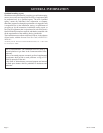
Page 320172-3-1006
Proper Log Placement
Log placement is critical to proper burner performance. Logs
must be correctly positioned onto the burner. The photos in this
manual show the proper pinned position for logs on this set.
Owners need to be shown proper log placement and instructed
not to move the logs.
Logs must fit firmly onto the burner when positioned as shown
in the photos. Malformed logs or logs with sloppy pin holes must
be replaced.
Proper Placement of Rock Wool and Decorative Lava Rock
Rock wool can be added to burners for a glowing ember effect.
It must be positioned only on the front portion of the burner. The
photos in this manual show the proper placement of rock wool.
Decorative lava rock or small wood pieces should never be placed
on the burner. These items are only for placement on the floor of
the fireplace or firebox.
Proper Primary Airflow into Burner
For proper burner operation and flame appearance, the flow of
primary air into the venturi tube, located on the rear of the burner,
must not be reduced. This flow of air is reduced if dirt, lint or other
obstructions build-up around or inside the venturi. Any obstruction
in the venturi tube area must be removed. The flow of air into the
venturi is also reduced if the gas orifice isn’t centered in the venturi
inlet and/or is not aligned with the venturi. Any misalignment of
the burner orifice may be corrected by bending the shutter cap
holding the orifice to the inlet of the venturi tube.
Ceiling Fans, Portable Fans or Logs Installed Near Cold Air
Returns
Ceiling fans or oscillating floor type fans need to be monitored
during the operation of vent-free logs. If the air blows directly
into the flame causing it to impinge on the log set, or firebox, it
should be turned off or redirected. Ceiling fans could be reversed
to possibly eliminate flame impingement, and the floor fan could
be redirected. Upon installation, be aware of any cold air returns
or vents in the proximity of the log set. Any draft created around
a vent-free log set can cause the flame to impinge on the log and
create a sooting situation.
WARNING: Do not allow fans to blow directly into the fireplace.
Avoid any drafts that alter burner flame patterns.
WARNING: Do not use a blower insert, heat exchanger insert or
other accessory not approved for use with this heater.
Candles
Avoid the use of scented or decorative candles while the log set
is in operation. Candles produce a residue in the air that creates a
soot like substance. Burning candles while the log set is operating
magnifies the problem. It should be noted that candles, in general,
produce soot. The amount of time burned and the quantity of
candles burned will determine the amount of soot produced and
deposited.
Make Owners Aware of Proper Log Set Operation
Properly installed and properly maintained log sets do not deposit
soot on the logs. If users see soot appear on a log, call for service.
Do not continue to operate the log set.
Sunken Fireplace
If installing this unit into a sunken fireplace, you must raise the floor
to insure adequate airflow and guard against sooting. Raise fireplace
floor using a non-combustible material, which is secure.
Glass Doors
Make sure that glass doors are open during all operations of the log
set. The opening of the glass door frame should be the dimension
used for the minimum front opening of the firebox.
Woodburning Fireplaces
The interior of the firebox and the chimney should be cleaned and
free of all creosote before installing a gas burning log set. Creosote
will soften when heated and can drop on the log set causing odors
and possibly sooting.
WARNING: Before installing in a solid-fuel burning fireplace,
the chimney flue and firebox must be cleaned of soot, creosote,
ashes and loose paint by a qualified chimney cleaner.
IMPORTANT INSTALLATION GUIDELINES


















